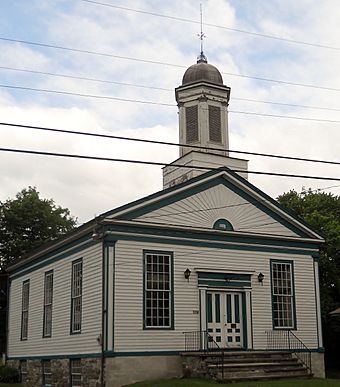Weybridge Town Hall facts for kids
Quick facts for kids |
|
|
Wesleyan Methodist Church
|
|
 |
|
| Location | Quaker Village Rd., near Jct. with Baker Ct., Weybridge, Vermont |
|---|---|
| Area | less than one acre |
| Built | 1847 |
| Architectural style | Greek Revival |
| NRHP reference No. | 96000387 |
| Added to NRHP | April 12, 1996 |
The Weybridge Town Hall is a historic building in Weybridge, Vermont. It stands on Quaker Village Road in the northern part of town. This building was first built in 1847. It started as the Wesleyan Methodist Church. Later, in 1893, it became the town's very first town hall. It is a great example of Greek Revival architecture. Because of its history and style, it was added to the National Register of Historic Places in 1996.
Contents
About Weybridge Town Hall
The Weybridge Town Hall is on the west side of Quaker Village Road. It is in a spread-out village area in northern Weybridge. This area is mostly along the east bank of Otter Creek.
Building Design and Features
The building is made of wood and has one story. It has a pointed roof and its outside walls are covered with overlapping wooden boards. On top of the roof, there is a tall tower. This tower starts with a square base. Above that is a six-sided section with openings, called a belfry. It used to hold a bell. The very top of the tower has a curved, onion-shaped dome.
The front of the building has flat columns at the corners. These columns go up to a decorative band called an entablature. The roof above the front forms a triangle, known as a pediment. This pediment has planks arranged like a sunburst. Inside the building, you can still see much of the original Greek Revival style woodwork. There are also old bench pews and light fixtures from the early 1900s.
A Church Becomes a Town Hall
The building was constructed in 1847. This happened after the local Methodist church group split apart. They disagreed about the issue of slavery. One group, who were against slavery, left the original church. They then built this new church building. The people who designed it were inspired by the books of Asher Benjamin. He was a famous architect who published design ideas. Many parts of the church's outside and inside look like drawings from his books.
After the American Civil War, the two Methodist church groups came back together. However, their numbers became smaller over time. So, in 1893, they rented the building to the town. The town started using it as its town hall. It was the first town hall for Weybridge. It is still used for town meetings and community events today.
Other Uses of the Building
The building also used to have the town's library in its basement. This was until 1911. That year, the Cotton Free Library was built right next door. In the 1990s, the Town Hall building was carefully repaired and made to look new again.
More to Explore



